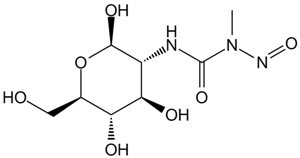Streptozotocin (STZ)
This product is for research use only, not for human use. We do not sell to patients.

For small sizes, please check our retail website as below: www.invivochem.com
| Size | Price | Stock |
|---|---|---|
| 2g | $350 | Check With Us |
| 5g | $550 | Check With Us |
| 10g | $825 | Check With Us |
Cat #: V1856 CAS #: 18883-66-4 Purity ≥ 98%
Description: Streptozotocin (also known as NSC-85998, STZ, Streptozotocin; U 9889) is a glucosamine-nitrosourea derivative and a potent DNA-methylating agent with IC50s of 11.7, 904 and 1024 μg/mL in HL60, K562 and C1498 cells respectively.
Top Publications Citing Invivochem Products
Publications Citing InvivoChem Products
Product Promise

- Physicochemical and Storage Information
- Protocol
- Related Biological Data
- Stock Solution Preparation
- Quality Control Documentation
| Molecular Weight (MW) | 265.22 |
|---|---|
| Molecular Formula | C8H15N3O7 |
| CAS No. | 18883-66-4 |
| Storage | -20℃ for 3 years in powder formr |
| -80℃ for 2 years in solvent | |
| Solubility In Vitro | DMSO: 53 mg/mL (199.8 mM)r |
| Water: 53 mg/mL (199.8 mM)r | |
| Ethanol: <1 mg/mL | |
| Solubility In Vivo | Saline: 30 mg/mL |
| Synonyms | NSC-85998; U9889; AI3-50821; NRRL 2697; U-9889; U 9889; NCI-C03167; NSC-85998; STZ; SZC; SZN; Zanosar. |
| Protocol | In Vitro | Streptozotocin (STZ) shows higher cytotoxic effect in vitro on hematological cell lines compared to Alloxan (ALX). ALX appeares not to be toxic for the studied cell lines with estimated IC50 values of 2809, 3679 or over 4000 μg/mL for HL60, K562 and C1498 cells, respectively. Streptozotocinn is more toxic, especially for the human myeloid leukemia cell line, HL60. The IC50 values of Streptozotocin are 11.7, 904 and 1024 μg/mL for HL60, K562 and C1498 cells, respectively. Results also show that the murine leukemic cells are more resistant to Streptozotocin and ALX cytotoxicity than human leukemic cells |
|---|---|---|
| In Vivo | Streptozotocin (STZ)-injected mice show tendency to have lower body weight than that observed in animals injected with ALX. Streptozotocin -injected mice have significantly fewer splenocytes (22.2±3.2×106; n=10) compared to mice injected with ALX (60.7±4.3×106; n=15; p=0.01) |
These protocols are for reference only. InvivoChem does not
independently validate these methods.
| Solvent volume to be added | Mass (the weight of a compound) | |||
|---|---|---|---|---|
| Mother liquor concentration | 1mg | 5mg | 10mg | 20mg |
| 1mM | 3.7705 mL | 18.8523 mL | 37.7045 mL | 75.4091 mL |
| 5mM | 0.7541 mL | 3.7705 mL | 7.5409 mL | 15.0818 mL |
| 10mM | 0.3770 mL | 1.8852 mL | 3.7705 mL | 7.5409 mL |
| 20mM | 0.1885 mL | 0.9426 mL | 1.8852 mL | 3.7705 mL |
The molarity calculator equation
Mass(g) = Concentration(mol/L) × Volume(L) × Molecular Weight(g/mol)
Mass
=
Concentration
×
Volume
×
Molecular Weight*
The dilution calculator equation
Concentration(start)
×
Volume(start)
=
Concentration(final)
×
Volume(final)
This equation is commonly abbreviated as: C1 V1 = C2 V2
Concentration(start)
C1
×
Volume(start)
V1
=
Concentration(final)
C2
×
Volume(final)
V2
Step One: Enter information below
Dosage mg/kg
Average weight of animals g
Dosing volume per animal µL
Number of animals
Step Two: Enter the in vivo formulation
%DMSO
+
%
+
%Tween 80
+
%ddH2O
Calculation Results:
Working concentration:
mg/ml;
Method for preparing DMSO master liquid:
mg
drug pre-dissolved in
µL
DMSO(Master liquid concentration
mg/mL)
,Please contact us first if the concentration exceeds the DMSO solubility of the batch of drug.
Method for preparing in vivo formulation:
Take
µL
DMSO master liquid, next add
µL
PEG300, mix and clarify, next add
µL
Tween 80,mix and clarify, next add
µL
ddH2O,mix and clarify.
Note:
- (1) Please be sure that the solution is clear before the addition of next solvent. Dissolution methods like vortex, ultrasound or warming and heat may be used to aid dissolving.
- (2) Be sure to add the solvent(s) in order.




































